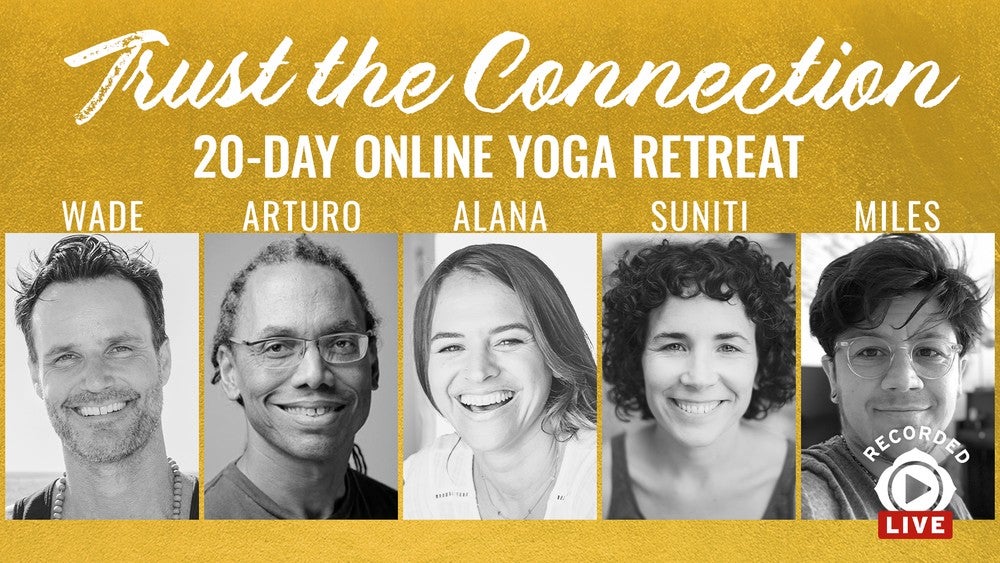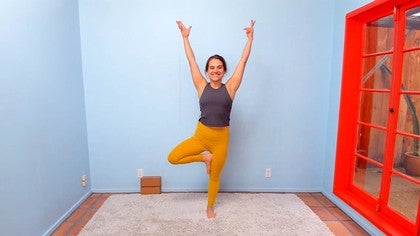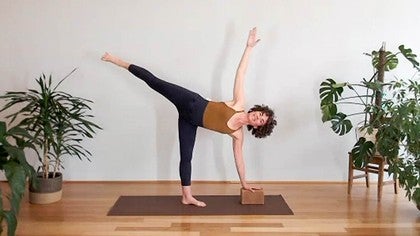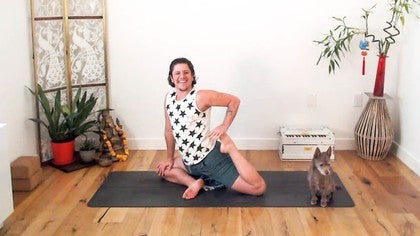Description
About This Video
Transcript
Read Full Transcript
Hi, everyone. It's day 20 of Trust the Connection. I can't really believe it. It's been such an amazing experience and I am just honored to be here with all of you and to have shared space with tremendous teachers who were all new to me and now I've grown to love so much. I feel like I'm going to miss everyone so much. It's been incredible for me to have this time with you. For today's practice, you will need two blocks if you have them, a hand towel or a belt and a towel, a bigger towel or a blanket. If you do have a belt, just go ahead and grab your belt. I was trained at a yoga studio who had a very neat prop situation. They always kept their props really neatly, so my belt is always neatly wound. So make a loop that's a medium-sized loop in your belt and you can set the belt off to the side for now. We won't need it for a little while. Then grab your blanket or your towel. This doesn't have to be any particular shape or it's not that important, I guess, how thick it is. You want it to be a little bit thick like a long noodle shape. Then just so we're clear, just to have a little anatomy just review, the hip creases are where your hips fold. That's where the blanket is going to go and we'll all start face down with the blanket right at the hip creases. It's not under the belly like an on a forest belly roll. It's really under your hip creases, which is where your hips fold and then find your chest on the ground. Find a situation for your head that feels like it's not straining your neck. I like to rest my forehead on my hands. Whatever last little movements you need to do to situate yourself, situate yourself. I like to lift one leg and reach through the toes and then kind of let it release again and then lift the other leg, reach through the toes and let it release again and pigeon toe my toes in, let the ankles kind of explode out. That broadens my sacrum. Here in this downward facing Shavasana, allow your weight to drop into the ground. This whole retreat has been about trust and connection, right? Trust the connection. So what connection exactly are we trusting and what does it mean to trust?
Let your weight drop down into the floor and allow the floor like a magic carpet to come up and carry you and receive your weight so that there's a sense of reciprocation there. You're being received as much as you are receiving. Trust is given. It isn't taken. But it is like Brené Brown says, it can be like a jar of marbles. You can put, you can practice or build trust by putting marbles in the jar, by doing little things or showing up in certain ways that give people in your life the sign to, that continually give people the sign in your life to trust you. Or you can take those marbles out a little bit at a time, which starts to deplete your trust. What happens if you receive the floor? If you let the floor receive you, can you with this restriction of the breath at the front of the body, because the floor is there, can you feel the breath a little bit more in the back of your body? And can you allow the sacrum, which is that triangular bone in the center of the back of the pelvis, to broaden with the breath as much as your low back and the space right under the ribs, which holds the kidneys. The kidneys are the, are big players in fight or flight. Can you let the breath move into your rib cage? Imagine that you had wings back there and perhaps you can move the breath into those amazing wings that you're imagining. And then where the blanket is in your hip flexors, can you release with that sensorial experience of the blanket being there, can you release your hip flexors? Is that even possible? And maybe today it's not, but can you put out like an invitation or a, you know, put out a sort of offering of softness there? And then notice how your whole back body responds and how your ability to give weight also responds. Something that I've really missed a lot in this time of quarantine and being without people so much. There's a thing called the, I don't remember who, but somebody who studies or who talks about the autonomic nervous system, he calls this the donkey experience. If you've ever been around donkeys, they kind of lean up against each other and they give each other weight. And even sometimes when you come up against a donkey, the donkey leans up against you and gives you their weight and that ability to give your weight over and be received automatically tells your autonomic nervous system, it symbols or gives a sign to your nervous system to soften and to release into a more social part of your neurology. So let that happen. You can give your weight into the floor here in a way that really releases it almost like you're snuggling up against the floor. And then the floor can snuggle back against you and give yourself three more breaths. From there you'll bring your hands by your ribs and press back into a child's pose. It might be that the head, the forehead lands on the blanket. It might be that you move the blanket off to the side and you just release into your child's pose. Let the knees be a little bit wide for this one and let the belly soften down toward the ground like Arturo says. We have to be willing to release our six pack. If I had a six pack, I'd know what he was talking about, but I don't. So fortunately I don't have that pressure. I can just release my belly to the floor. Roll yourself slowly up to sit. And then from there, if you can sit in a supported Virasana with a block in between your heels, do that. If this is too much for your knees, then perhaps a better option is to sit cross-legged. I like to sit up on something so that my hips have the opportunity to be lifted above my knees. And you know, sitting upright is not really comfortable. It's a practice that already has a certain amount of rigor to it. So give over to that rigor, embrace it, find the form and then close your eyes, rest your palms face up on your thighs and settle into the form by softening the breath from the inside out. You might begin your Ujjayi breath, that breath that sounds like the ocean that reminds you that you were of the ocean once, that reminds your body that your body's like 78% water. So it has an ability to respond to all that fluid as the inhale comes in and as the exhale comes out. We'll continue with Baba Nam, Kevalam. Baba Nam, Kevalam. We've been singing it the last two practices with me and I think it's good to just continue, dive deep into it, calling to the most ancient part of ourselves and you could call in or you could call out. It's really up to you how you work with calling.
Really interesting, right? We can listen in different ways. We can experience vibration in different ways. Listen. Baba Nam, Kevalam. Baba Nam, Kevalam. Baba Nam, Kevalam. One more time. Baba. Om Kevalam Baba Baba Nam Kevalam Baba Nama Om Kevalam Baba Baba Nama Kevalam Baba Nama Kevalam Babanob Cave Alah Babanob Cave Babanob Cave Alah Babanob Cave Babanob Cave Alah Babanob Cave Babanob Cave Alah Palms together, deep inhale Open your eyes, open your eyes, open your eyes. You will meet on your hands and your knees. Have your blocks handy on either side of the front right side and left of your mat.
You may decide that you want them. And then from there, walk yourself back so that you're on your shins. If this is a hard situation for your knees, slide a blanket over your knees. And then we're going to start by inhaling the arms out and up. And on the exhale, arms out and down, round, forward.
A pranami bowing forward. Inhale, reach up, lift your chest up, lift your spine up, arms out and up. Exhale, round, round, round, round, round, forward. Balasana, child's pose. One more, inhale, roll up, round up, reach up.
And on the exhale, round, round, round, round, round. Walk your arms forward. Pull forward into a cow pose. Tuck your toes under. Press up and back into a short down dog as you walk your hands back to your feet.
Inhale, lengthen your spine, pull your chest forward. And on the exhale, fold over your legs. Round yourself all the way up to stand nice and easy, tailbone heavy. Inhale, reach your arms out and up. And on the exhale, chin into the chest, rounding, rounding, rounding, forward and down.
Knees soft. Hands onto your shins or onto the floor. Inhale, come through, rounding to open the chest. Flat back, exhale, fold. Soften your knees, round all the way up to stand, all the way up to stand.
Inhale, reach the arms out and up. On the exhale, chin into the chest one last time, rounding, rounding, rounding, all the way down. Inhale, roll through a cat into a cow. And on the exhale, round and fold, round yourself all the way up, all the way up, all the way up, all the way up. Close your eyes for a moment and feel here how you feel with your back body, how you feel with the front of you, how you feel with the floor coming up to carry you.
Is there a sense that there can be an energy that ricochets up your spine? In a sense that the spine can be kind of liquid even here. From there, your hands are going to come like a little soap dish. You can rest the dominant hand over the least dominant hand. Look about a foot and a half in front of you.
Find a drishti point out there in front of your mat. And then the only instruction I'll give is to pay attention as we take a little walking meditation to the front of the mat.
Trust the Connection: 20-Day Yoga Retreat
Comments
You need to be a subscriber to post a comment.
Please Log In or Create an Account to start your free trial.
















